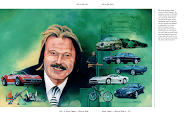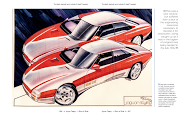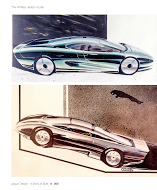Nick Hull is to be congratulated for producing Jaguar Design: A Story of Style – a benchmark in authorship pulling together in sure-footed detail, the diverse strands of Jaguar design.
Contained within no less than 512 pages is a superb composite of the evolution of a brand, a marque that has stood the test of time, despite actions by various owners and even more managing directors until landing in the hands of Tata.
Titled
Jaguar Design. A Story of style this
epic covers the design story of Jaguar, from sidecars to supercars. But what is
design and what is style? The Glossary has no definition of either word.
Perhaps they are so well understood by industry’s cognoscenti that there is no
requirement for definition. But others outside this circle may appreciate
enlightenment.
Ian
Callum, Jaguar's esteemed director of design explains: "Design is about
dealing with facts….It is about creating cars that people want to buy….Good
design can be drawn in two or three lines."
But
style. What is style? Answers on a postcard please!
And
is the word style important anyhow? Tom Karen, formerly managing director of
Ogle Design, suggests: "That the design of a vehicle body is an art form
using the same language and techniques as, say, Henry Moore used to do his own
work – with a lot of added complications: legislation, the package, choice of
materials."
A distinctive appearance
Style, like design, is not
about repeating but creating something new. Style is perhaps an outward and
visible sign of inner human feelings and emotions and their expression into a
tangible form on paper, in digital form, in clay, and eventually sheet metal. Style
is also about good proportion, shape and silhouette, colour, and the optimum
expression of metal.
So when someone says: “Such
and such has style,” what do they really mean?
The
Oxford Dictionary defines style as: A
distinctive appearance, typically determined by the principles according to
which something is designed.
The
word style is probably best suited to design for the fashion industry – producing
clothes for women to make them appear smart, alluring and sexy using means that
are superficial and often not functional.
For this reason, styling applied to cars was considered by some in the
design profession as a phony, cosmetic kind of activity, far removed from ‘real’
product design where 'form follows function'.
Does
it matter if we can't define style? Perhaps it is a word everyone recognises,
but doesn't know its meaning; or doesn’t even care.
Most
who buy motor cars never see the sketches and renderings that form part of the
tortuous process of approval and counter-approval.
Don’t judge
a book by its cover
It is said that one can't
judge a book by its cover, and this book should not be judged by its cover,
which may not be the best use of art to reflect a British sports car icon and an
equally monumental book about Jaguar design and style.
The
dust jacket has design, but has it the style to reflect the pedigree of the
cars the author so admirably describes?
The
book can, however, be judged by its weight. At no less than 3075g – 3.075kg – this
detailed volume is not one to slip into the pocket! It is however a time-line
of Jaguar in design – and style – from the beginning until now. Focusing on
those responsible for design and style, it surely is a masterpiece in its own
right, ideal for those who missed, or were not able participate in the hidden
parts of Jaguar to which few gain access.
Hull
leads the reader gently but competently through the corridors of time to create
an epic testimony to Jaguar’s style, a real treasure-trove of memories.
He
also portrays how ‘styling’ has migrated from an also-ran department to mature ‘design’
status at main board level.
This
maturity in status for styling apparently grew from the appearance on the
Jaguar scene of Ian Callum. Even with 12 years at Ford and nine years at TWR
under his belt, Callum’s induction into Jaguar’s hot seat of creativity would
likely not have happened but for the untimely and premature death of chief
designer Geoff Lawson (above) on 24 June 1999, following a huge stroke.
The call he had been waiting for
Hull sheds light: “Callum got
the call he had been waiting for all his life; the chance to be Styling
Director of Jaguar.”
He
adds: “There was a feeling that Jaguar had rested on its styling laurels for
too long. So much so that the first thing Callum did was to demand the change
of the name of his position to Design Director rather than Styling Director.”
“It’s
very important that we apply some interest to what we do,” declared Callum.
So,
there it is. There is a difference between style and design. Callum’s arrival
coincided with the motor industry’s drift away from 'styling' studios to
'design' studios.
And,
in the migration of status from head of department to main board level, Callum
has for some years been one of Jaguar’s executive committee members. This
highlights the importance of design as a centre of creative activity within
business and its key role in helping to generate profit, cash and future
product flow. Design can play a part in shaping businesses to win trade. Today,
it has an equal to engineering, manufacturing, purchasing and finance.
Was
the Blackpool-born and “undemonstrative” William Lyons, Jaguar's founder, a
designer? Or a stylist? Or neither? He certainly knew what was required in a
motor car to generate excitement sufficient enough for people to want to own
one. In his own way, without going to design college, and without probably
knowing the definition of either design or style, he could create a vehicle with
form and function.
The
big business change for Sir William Lyons occurred on 6th July 1966 when he
agreed a takeover of Jaguar Cars by British Motor Corporation (BMC). The
announcement came on 11th July 1966. (British Motor Holdings – BMH – had been
known as BMC until 14 December 1966.) Thirteen months later, under Labour
government pressure, BMH merged with Lord Stokes’ Leyland Motor Corporation.
References
to Lyons abound, as do those to one of Jaguar’s biggest losses – Geoff Lawson.
Lawson’s legacy, surely, was the £6.3 million Advanced Styling Studio that he largely
initiated and ironically was signed off on 25th June 1999 – the day
following his death – and from which evolved a new “design language”.
Varying degrees of success
From its very outset Jaguar
has ploughed a single furrow, but not without several senior executives playing
their part, with varying degrees of success. Some escape with little exposure,
though one suspects they exerted a controlling influence on the levers of power
that affected styling and prototype production.
One
such escapee must surely be Geoffrey Robinson (with his convoluted dealings
with the Italians); others include John Barber, Lord Stokes, Sir Michael
Edwardes and Ford’s Bill Hayden who took over from John Egan, one of Jaguar’s
most successful bosses.
Hull
gives such men little space, with the exception of Egan, of course. It is not a
book about Jaguar management. Instead he sheds light in dark corners where
light has seldom fallen before in such profusion, namely those who have
designed (or is it styled?) well-known Jaguar cars – from C-type, D-type, through
E1A and E-type, to F-type and F-TYPE. Included are Jaguar’s cars with experimental
numbers (XJ1 to XJ220B), Daimler’s codes (XDM1 to XDM61) and X codes under Ford
– X100 to X760. XJ80 pictured above.
Owners
too along the way have poked their fingers into its affairs and generally messed
it about: British Motor Corporation, British Motor Holdings and British Leyland
Motor Corporation, with Ford Motor Company being most notable. Of all the
owners thus far, Tata seemingly is by far the most sympathetic to Jaguar’s cause.
Revealed
too are prototype shops, their task one of tirelessly and endlessly, without
glamour, glory and ceremony, transforming style and, sometimes impossible profiles,
into complex sheet metal parts (without cracks) and finally into finished
product.
Given
recognition are Abbey Panels, Motor Panels – but not Mayflower Corporation (or
Airflow Streamlines) – Park Sheet Metal, Pressed Steel/Pressed Steel Fisher and
Venture Pressings Ltd (VPL), a curious venture of Jaguar and GKN that failed.
VPL
played a key part in the life of the XJS. It started life in May 1991 as the
first major programme Ford Motor Company approved following its acquisition of
Jaguar.
A Jaguar-discarded business
In late 1994, Jaguar and GKN
disposed of VPL to Ogihara Corporation of Japan, a pressings supplier in the
mid-1990s to Ford; however, the writing was writ large on the wall in mid-1993.
Negotiations were handled by Jaguar director Mike Beasley.
So,
the Jaguar-discarded Telford-based VPL became known as Ogihara Europe Ltd.,
only later to be acquired by Stadco which, with Polynorm, had managed Jaguar’s
new Castle Bromwich press shop containing Schuler press lines that for the
first time heralded the arrival of aluminium bodysides and other pressings.
In
a further twist, Stadco purchased for a snip the newly-built gem of a press
shop at Fort Parkway (right next door to Castle Bromwich) built by Mayflower
Corporation. This can stamp steel and aluminium bodysides using almost
identical press lines to those at Castle Bromwich. Those press lines now stamp some
panels for Jaguar sports cars.
Mayflower’s
directors had the foresight to see Jaguar – and others – would need more press
shop capacity than Castle Bromwich, etc. could supply. Mayflower took the risk
and failed (through poor management) before Jaguar’s further expansion into
aluminium materialised.
Only
Hull knows if he has done a good job, but one suspects he is proud of the end
product; only he knows of any microscopic faults.
Certainly,
any author would be happy to attach his name to this epic which is certain to
stand the test of time as a record of who did what, where, when, why and how in
Jaguar design.
People like Mercs but love Jaguars
It is a book for those who love Jaguars and all that the marque stands for in the annals of automotive design.
As
much as anything it is an encapsulation of unsung heroes; stylists who carve their
future in clay; sheet metal companies who carve their future in formable
materials – groups who seldom if ever hit the headlines because of the secret
nature of their work.
With
many illustrations that readers will not have seen before, Hull brilliantly
opens the cupboard to show what did happen – and what didn't. It is certainly
the book you might wish to leave on a coffee table; that might spark a discussion
about design, and style! And whether the jacket has design and style.
Several
car designs inevitably mark turning points for Jaguar. The company's designers
will have their own recollection of what these might be.
One
design stands out for this reviewer; X600, a car that could have been ahead of
its time, but never appeared as intended, marked the parting of the ways.
Hull
explains: “The car was planned to have an aluminium structure similar to that
of the X350, and considerable resources were put into the project, with over
100 engineers employed on the programme during 2001.”
X600
– fundamentally flawed
Here Hull takes in comments
from Callum: “The X600 F-type represented the last manifestation of the retro
soft-surface sports-car theme that, while it pleased Jaguar sentimentalists,
was increasingly out of step with shifting design tastes. This was an exciting
and promising proposal yet again to establish a Jag two-seater – the name clearly
signalled its intention.”
Still
referring to X600, Hull continues with Callum: “But although it caught the
imagination of many, including Ford boss Jac Nasser and design boss J Mays, who
both loved the car, the design was fundamentally flawed. It worried me at the
unveiling, because I knew that by the time it had gone through all its legal
and feasibility requirements it could look quite ordinary.”
More
Callum: “We continued with the design to make it feasible but the required
windscreen height and legal bonnet height took so much away from the exciting
proportions. At this point I instigated the idea of a mid-engine car…which
developed to a significant level of design and engineering before it was
dropped so the company could pay for some new diesel engines. From a business
point of view (it was) the right thing to do, but it broke my heart.”
Added
Callum: “Ford was in deep trouble at those times. It was struggling to reverse
losses in its core North American operations and CEO Jac Nasser was ousted in
October 2001 as a result of dissatisfaction with his leadership. Nasser’s
tenure was also marred by a scandal over deadly accidents involving Ford
Explorer sport-utility vehicles and the defective Firestone tyres with which
they were fitted.”
“Subsequently,
Jaguar chairman Wolfgang Reitzle (of BMW) also resigned in early 2002 in the
light of severe cut-backs at PAG (Premier Automotive Group to which Jaguar
belonged with Aston Martin and Volvo). The X600 F-Type was cancelled and the
Jaguar F1 operation was wound up.”
“Mark
Fields became chairman, then Lewis Booth took over in 2005, running PAG and
Ford Overseas Operations until the sale of Jaguar to Tata in 2008”.
In
these few paragraphs are found key words that over-arch car design – and
styling – namely, shifting design tastes, business, legal, feasibility,
proportion and heart.
Celebrating 75
years of Jaguar
Of course, X600 work was not
entirely wasted. In 2009, a year into Tata’s ownership, the idea blossomed of
celebrating 75 years of Jaguar and with it the concept of the C-X75 supercar.
“Of
course, we always wanted to do a supercar,” claims Callum. “But were conscious
that any extreme performance would need to include sustainable technology.”
Interestingly,
he adds, we “discovered our research
department was working with turbine technology as potential generators and
decided this would be a perfect opportunity to do something different.”
And
so began Jaguar’s work with Bladon Jets, also of Coventry, to develop a micro
gas turbine engine for C-X75. Tata’s boss, Ratan Tata, even opened Bladon Jets’
new facilities. Since then, not much has been heard of the micro gas turbine
company which describes itself as a world leader in these machines, now
promoted for power generation use. Dr. Ralph Speth of Jaguar Land Rover is
shown as a director.
Just
as the XJ-220 (above), and its links with Jim Randle, was built in collaboration with
TWR, so for C-X75 Jaguar turned to another motorsport icon – Williams Advanced
Engineering. From that collaboration spun out the eventual announcement in 2011
that 250 of this carbon fibre car would be built for sale.
A
year after C-X75 a further advanced concept arrived, the C-X16, effectively a
reworked ‘teaser’ preview of the exciting new F-TYPE compact sports car that
the main studio had been working on for two years “using a new aluminium
construction and which was one of the first projects given the go-ahead by
Ratan Tata once he had gained control of Jaguar in 2008.” A faint hark-back to
X600 and all that.
Anyone
interested in car design, and even car styling, will benefit from immersing
themselves in this thought-provoking and immensely enjoyable treasure-rove by
Hull who claims 25 years’ experience as a designer, writer and academic on
automotive design, having worked at Jaguar on XJ41, XJ220 and XJS facelift,
Honda, Peugeot and TWR where he was involved in “bringing the Jaguar XJ220 into
production”.
Jaguar Design – a Story of Style. People –
Process – Projects. By Nick
Hull is published by Porter Press International, price £90 (US price: $169.95).
See porterpress.co.uk




No comments:
Post a Comment